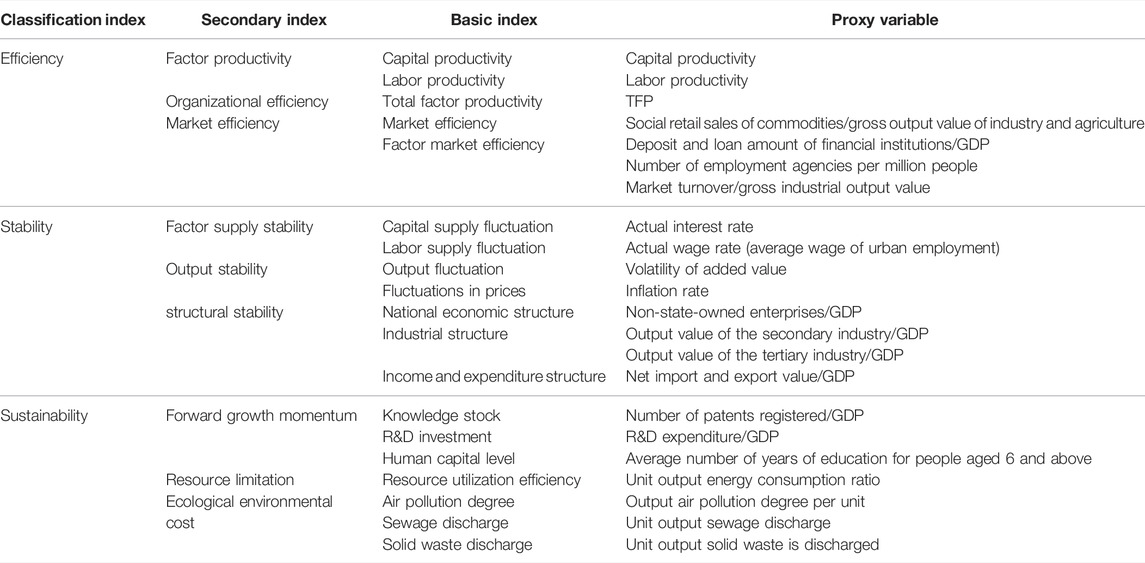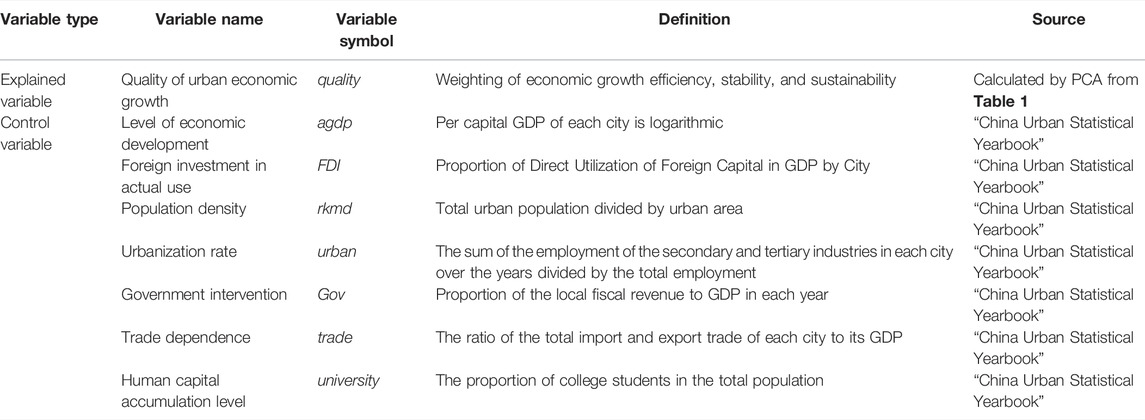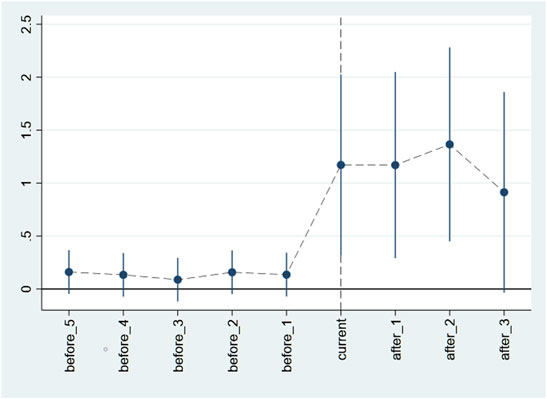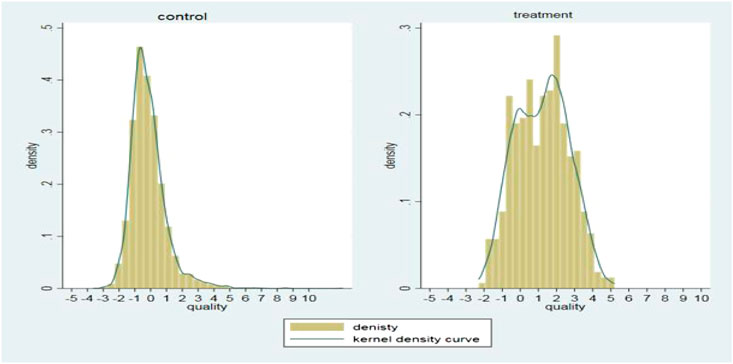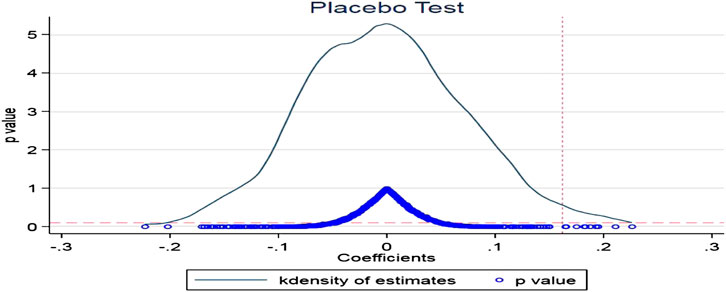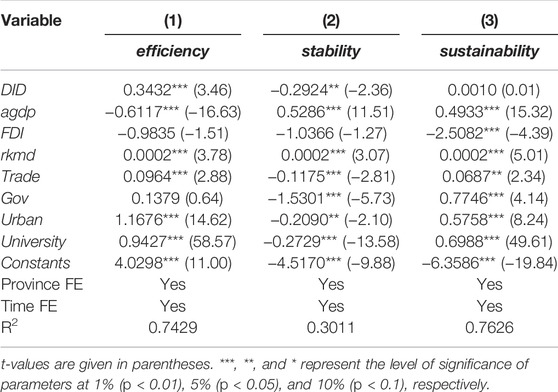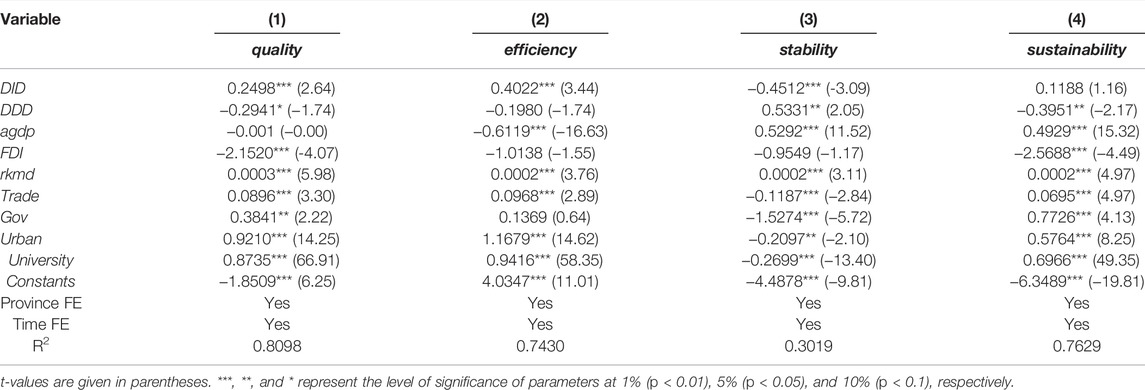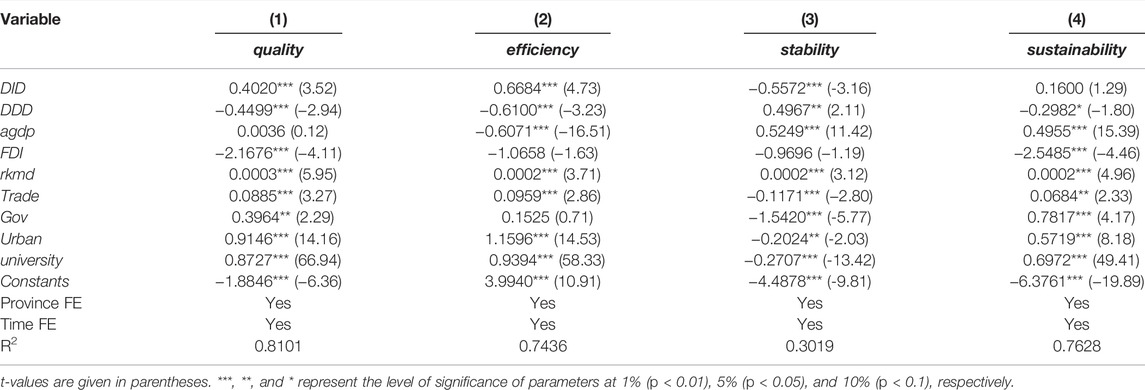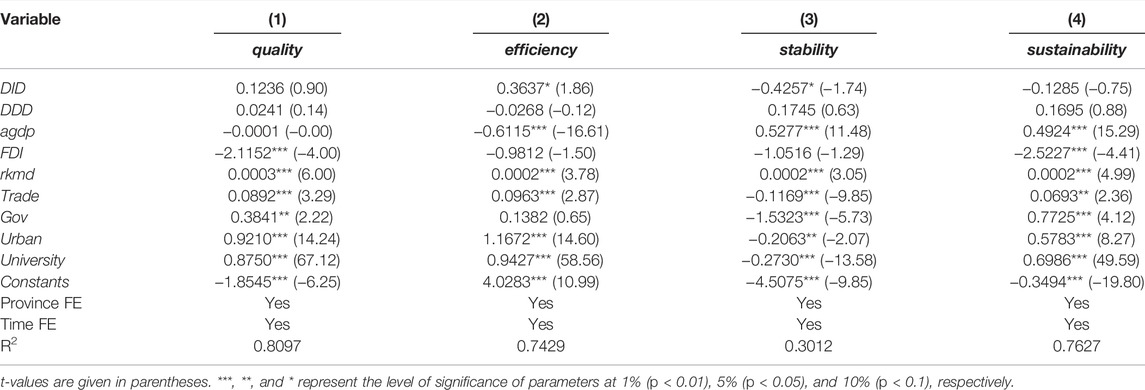- 1School of Economics, Shandong University, Jinan, China
- 2Nanning Sub-branch of Science and Technology, Agricultural Bank of China, Nanning, China
China–Europe freight train (CEFT) is a link connecting Eurasia and a vital carrier to promote regional economic cooperation. This article measures the quality of China’s city-level economic growth using principal component analysis. Our study examines the impact of the opening of CEFT on the quality of urban economic growth by using the multi-period difference-in-difference (DID) model and the data of 273 prefecture-level cities in China from 2003 to 2016. First, the basic results show that the opening of the CEFT significantly improves the quality of the economic development of node cities, which remains robust under a series of robustness tests. Second, the heterogeneity test shows that CEFT is more conducive to improving the quality of economic growth in inland cities and cities with small freight volumes in central and western China. There is no significant difference in the impact of road infrastructure construction in different level cities. Third, the mechanism test shows that the opening of the CEFT has a significant impact on improving the quality of economic growth, with no positive effect on stability and sustainability. The construction of the CEFT is still under development. It is necessary to take complete account of the situation of different cities in scientific planning, improve its driving effect on stability and sustainability while maintaining efficiency, and then, optimize the economic benefits of the freight train.
1 Introduction
Since the outbreak of COVID-19 in 2020, the global economy has been severely impacted and trade protectionism and unilateralism have resurfaced. The Chinese government has taken a series of measures to strengthen economic cooperation with neighboring countries and actively promoted regional economic integration to cope with the complex external situation. Opening China–Europe freight train (CEFT) is an essential measure of regional integration; it connects the Europe and Asia economic circle of international trade and provides another important transport besides road, sea, and air transportation choices. The upgradation of transport infrastructure also improves the county’s economic development (Cigu et al., 2018). In the case of the Freight train, China initiated a new bridge to expand the China–Europe economic and trade exchanges and cooperation for the transfer of marketing and production and provides firm support. It has a radiating and driving effect on business and industry in the regions along the belt and road, providing a new platform for China to expand foreign exchanges further and develop opening up to the west. Wang et al. (2020) also revealed that transport infrastructure in the belt and road countries plays an essential role in facilitating economic growth.
The impact of transportation on sustainable development and economic growth has become a concern for policymakers and economists. Many previous studies have analyzed the implication of transport infrastructure on sustainable economic growth (Pradhan and Bagchi, 2013; Beyzatlar et al., 2014; Pradhan et al., 2014; Arvin et al., 2015). Infrastructure is an essential wheel of the success of a country’s effort to increase its productivity growth (Esfahani and Ramirez, 2003; Elahi et al., 2021b). It reduces travel time, and passenger and freight transport gain from cost time and saving (Satya, 2003) attracts foreign direct investment (Esther and Nancy, 2004), expands trade, and links together resources and markets in an integrated economy (Aschauer, 1989). Zhou et al. (2021), in the case of China, revealed that infrastructure investment improves economic growth through the physical and material circulation of resources, market integration, and knowledge capital evolution. Achour and Belloumi (2016) also suggested that infrastructure investments generate higher economic growth. Many other studies also proved the positive repercussions of the development of large-scale transport infrastructure to stimulate regional economic growth (e.g., Zhang et al., 2019; Jiao et al., 2020; Yang et al., 2020). In the case of China, transport infrastructures, exceptionally high-speed railways, are also found responsible for sustaining the economic expansion of the Chinese regions in the aftermath of the world financial crisis (Yao et al., 2019). Even in developed countries, railways are considered a dominant factor driving the growth and development of the country (Fishlow 1965). Atack et al. (2009) suggested that railways accelerated American Midwestern urbanization during the 1850s.
Thus, there is a strong relationship between transportation infrastructures and economic growth. However, some studies also unveiled contradictory findings such as the work of Locatelli et al. (2017) which showed that large transport infrastructure projects are often high priced and fail to deliver the promised benefits. Crescenzi and Rodriguez-Pose (2012), Crescenzi et al. (2016), and Maparu and Mazumder (2017) also found that transport infrastructure had ambiguous, insignificant, or even negative effects on economic growth. To extend the previous literature, the current study explores the impact of international transportation interconnection between China and Europe and its impact on the quality of urban economic growth.
As China’s economic development has entered a new normal and its economic growth has slowed down, the quality of economic growth has attracted much attention. On the one hand, most of the existing literature studies economic growth from the quantitative level; on the other hand, the impact of transportation infrastructure construction on economic growth is also uncertain. However, few works have studied the relationship between CEFT and the quality of economic growth. Therefore, our article uses scientific methods to measure the quality of economic growth and hopes to explore the impact of CEFT on the quality of China’s economic growth, so as to provide some theoretical reference for the country to make reasonable policies to promote the quality of economic growth in the future. However, the opening of China–Europe freight train is always a dynamic process. As the data measured in this article only reaches 2016, further research can be carried out in the future.
2 Literature Review
Unlike previous studies that focused on the agricultural (Elahi et al., 2019a; Elahi et al., 2019b; Elahi et al., 2020; Elahi et al., 2022a; Elahi et al., 2022b) and industrial sector (Zhao et al., 2020; Liu, 2021; Zhao et al., 2021), the current study emphasized on the transportation sector. As an essential public infrastructure directly involved in social and economic activities, transportation facilities are considered to play a vital role in economic growth. Scholars at home and abroad have researched improving transportation infrastructure to promote economic growth. Perfect transportation facilities can improve transportation accessibility and reduce transportation costs. Behrens (2011) and Shepherd (2016) analyzed that a country with an ideal transportation infrastructure can enhance trade comfort by reducing transportation costs. However, existing studies mainly focus on the impact of improving transportation facilities within a country on its economic growth. However, there are few studies on the effects of the construction of international transportation facilities on the economic development of the CEFT as an essential means of transportation connecting China with Europe and countries along the belt and road.
Through literature review, it is found that many studies believe that transportation advantages created by CEFT can promote the formation of industrial agglomeration in the opening regions and, thus, produce economies of scale effect. Kohlhase (2003) pointed out that convenient transportation is an essential factor affecting enterprises’ investment location choices. An area with perfect transportation can make it more convenient for the peripheral aspects of production to flow to the central region, and it is easier to form an industrial activity center, thus forming industrial agglomeration and sharing information and infrastructure resources within the region (Fang et al., 2020; Elahi et al., 2021a). The effect of factor allocation and economies of scale is conducive to high-quality economic growth (Elahi et al., 2022). The study of Burger and Meijers (2016) confirmed that international transportation connectivity increases regional connectivity, attracts more enterprises to participate in international trade, and improves the profit level of relevant enterprises. Liu and Li (2020) studied the sample of prefecture-level cities in China. They found that the promotion effect of the CEFT on the processing trade volume of cities along the route was greater than that of general trade. CEFT also changed the pattern of industrial agglomeration and improved the technological innovation level of enterprises and the scale of relevant government financial expenditure.
Some studies believe that the CEFT will also improve material flow, talent flow, and information technology spillover in the opening areas and promote technological upgrading and innovation level of enterprises by external effects, thus driving regional economic development. Grossman and Helpman (1990) believed that technology would flow between countries and international trade, thus forming spillover effects. Wang and Bu (2019) confirmed the existence of such a mechanism in their study of CEFT. The opening of the CEFT train promoted the innovation level of Chinese enterprises through international trade. On the other hand, the industrial agglomeration caused by the start of freight trains brings in many production factors such as raw materials and intermediate products, which provides sufficient and convenient production conditions and material basis for enterprises and improves their production efficiency. In addition, industrial agglomeration will also attract many high-tech enterprises, scientific research institutions, scientific research, and management talents to concentrate in the area, bringing advanced technology and management experience, which is easy to form the concentration of innovation factors. Liu and Zhang (2009) pointed out that external effects brought by talent flow and technology spillover can improve the enterprises’ overall technological innovation ability, meet the export enterprises’ demand for talent, adapt to the requirements of entry barriers in foreign markets, guarantee the quality and production efficiency of export products, and improve export scale and competitiveness. In addition, the opening of the CEFT also accelerates the trade between China and countries along the belt and road and enables enterprises in the agglomeration area to absorb the radiation of knowledge spillover from the wider network, promoting the integrated development of local knowledge and global knowledge (Tao et al., 2018) and driving the high-quality growth of the regional economy.
Through reviewing the existing literature, it can be found that from the perspective of transportation condition improvement and industrial agglomeration, many studies have demonstrated that the opening of CEFT is conducive to expanding the import and export of enterprises, improving regional openness and promoting economic development. However, most of these literatures are only single-dimension analysis, which is effective for mechanism analysis and can roughly clarify the path of the impact of CEFT on economic development. The single index measurement method covers less information and cannot comprehensively and persuasively describe the overall economic growth. On the other hand, there is a general inconsistency between the quality and quantity of economic growth. As China’s economic development has entered a new normal and its economic growth has slowed down, the quality of economic growth has attracted much attention. However, there has been no in-depth study on this issue in the existing literature on CEFT.
Therefore, this article may contribute to the literature in the following aspects: first, from the perspective of growth quality, this article evaluates the impact of the CEFT on urban economic development. The existing policy objectives have shifted from emphasizing rapid economic growth to improving the quality of economic growth, but the current literature still stays at the quantitative level. Following the method of Sui and Liu (2014), this article builds a comprehensive evaluation index system, extracts principal components by principal component analysis (PCA), synthesizes growth quality indicators by dimensionality reduction, and evaluates the role of the CEFT from the perspective of growth quality. It provides more empirical evidence for better construction of the CEFT. Secondly, in terms of empirical logic, this article combines external linkage with internal growth, examines the impact of regional integration measures on domestic growth incremental improvement, expands the logic chain of growth research, and provides rich heterogeneity tests from three aspects of growth efficiency, stability, and sustainability.
3 Materials and Methods
3.1 Variables
3.1.1 Dependent Variable
The measure of the quality of economic growth (quality: high quality of economic growth mode) should be efficient growth with stability, sustainability and efficiency, stability, and sustainability of broadly measuring the quality of economic development (Peng et al., 2020a; Peng et al., 2020b; Peng et al., 2021). The evaluation system of this article selects the growth efficiency, stability, and sustainability of three classification indices, drawing lessons from Sui (2017) method of sub-indices of the following chosen dimensions for each classification index, as shown in Table 1.
As explanatory variables used in the later econometric model in this article are all positive indicators, the variables are uniformly converted into positive indicators, and the positive indicators remain unchanged. All backward indicators are taken in a reciprocal form, and the reciprocal deviation of moderate indicators is taken. The mean value method is used to deal with the dimensionless proxy variables of basic indicators to solve the problem of inaccessibility. The comprehensive index and three classification indices of economic growth quality are obtained by the dimensionality reduction of the basic index. The selection and measurement of basic indicators have been introduced in detail in many articles such as the work of Sui and Liu (2014) and Chao and Ren (2011), which will not be described in this article.
This article selects 273 prefecture-level cities as the research object. In this way, the research object includes 273 samples with 19 fundamental indicators for each sample. The period is from 2003 to 2016, with 72618 data. The data used in this article were collected from the “China Urban Statistical Yearbook,” “China Population and Employment Statistical Yearbook,” and local “statistical yearbook” from 2003 to 2016.
3.1.2 Core Explanatory Variable
The DIDit is the interaction of the policy dummy variable (Treat) and time dummy variable (Post). Based on the sample data of 273 prefecture-level cities in China from 2003 to 2016, the policy dummy variable and time dummy variable are defined with the following primary considerations: on the one hand, for a particular city, the operation of CEFT mainly includes two states: “beginning” and “through”. This article pays more attention to the “beginning,” mainly considering that the goods carried by the train are basically direct to Europe and the goods are also distributed in the place of origin. Therefore, the prefecture-level city in the “normal originating city” of the CEFT is set as the processing group. The corresponding treat value is 1; otherwise, the value is 0. On the other hand, some cities have started to open more than one freight train line partly; this article takes the first route traffic as the opening date. At the same time, as the opening date of some lines is at the end of the year, the effect generated in the opening year of these lines may not be visible in a short term; so, this article adopts the method of uniformly delaying the opening in the second half of the year by 1 year. For example, if Wuhan opened the CEFT in October 2012, the value of Post is one from 2013. On the contrary, if the launch time is in July of the current year or earlier, the value of Post is one from the current year; as an example, if the launch time is in March 2011 in Chongqing, the value of Post is one from 2011.
3.1.3 Control Variables
As for selecting control variables, based on the availability of relevant literature and data, this article sets the variables of per capita GDP, FDI, population density, urbanization rate, government intervention, trade dependence, and human capital accumulation level at the city level. The logarithm of per capita GDP (agdp) is used to represent the level of urban economic development (Peng et al., 2019). The logarithm of the actual amount of foreign capital utilized (FDI) represents the situation of attracting foreign capital, which reflects the attractiveness of the city’s resource conditions or policies to foreign capital. Population density (rkmd) measures the abundance of the urban labor force and human capital. The urbanization rate reflects the overall development level of a city. Government intervention is quantified by the proportion of the fiscal revenue to the city’s GDP. The degree of trade dependence is expressed by the ratio of the total imports and exports in the city’s GDP. The level of human capital is reflected by the number of colleges and universities per capita in cities. All variables are described in Table 2.
3.2 Source of Data
This article selected panel data from 273 prefecture-level cities in China from 2003 to 2016. In the sample selection of prefecture-level cities, cities that have undergone an administrative division adjustment and have a large number of data missing are excluded and some cities in remote areas such as Tibet and Xinjiang. The core explanatory variable is whether the prefecture-level city has opened a freight train. The opening time shall be determined by the operation time of the first train in the city. This article manually sorted out the progress of the operation of the CEFT in cities from 2011 to 2016 and determined the operation time of the first freight train in each city by searching the website of China Railway Corporation, the website of China’s Belt and Road Initiative, and Baidu Encyclopedia. To ensure the accuracy of the data, the operation of the CEFT is compared and matched by searching the official website of the government and the newspaper of China National Knowledge Infrastructure. Considering the lag of the operation effect of the CEFT, this article will uniformly treat the cities that open freight train in the second half of the year as the first stage of lag. After the adjustment, by the end of 2016, a total of 30 cities became the processing group for the opening of the CEFT. Other macroeconomic data were collected from the “China Urban Statistical Yearbook” and “China Regional Economic Statistical Yearbook.”
3.3 Model Formation
Since the opening of the CEFT service, the rapid development, and the number of cities opened year by year, there are still many cities that have not opened the CEFT service. The opening of CEFT can be regarded as an exogenous policy impact to each city. Therefore, the DID model can be adopted to evaluate the impact of CEIBS on the quality of urban economic growth by taking cities with CEIBS as the treatment group and cities without CEIBS as the control group. However, since the opening time of the CEFT in different cities is different, to better judge the causal relationship between the occurrence of such temporal and spatial dislocation and the quality of urban economic growth, this article adopts a more general multi-period DID method to identify, and the benchmark model is as follows:
where qualityit represents the quality of urban economic growth (i and t represent city and year, respectively, the same below); DIDit for double-difference factor is the virtual policy variable; Treatit (if the city opened freight trains, the value is 1, otherwise 0) is the time of the cross-terms of virtual variables; and Postit (each city freight trains opened and after 1 year, before the opening of 0) is the reaction of CEFT for city net effect in the quality of economic growth. If the coefficient β1 is significant, the quality effect of economic growth is significant. Controlsit is a series of control variables; given the panel data, time fixed effect and province fixed effect are also considered. εit is the random interference term that is assumed to be normally distributed at zero means value and constant variance (Elahi et al., 2017; Elahi et al., 2018a; Elahi et al., 2018b; Gu et al., 2021).
The quality of urban economic growth was evaluated comprehensively by three indicators of efficiency, stability, and sustainability. Whether growth is simply caused by additional factors or the result of efficiency improvement is the embodiment of the transformation of economic growth mode, which can determine the capacity and level of economic growth. Stability reflects the tolerance of economic growth to external shocks and adaptability to external environment. High-quality economic growth should be steady in progress with slight fluctuations; sustainability reflects the potential of long-term economic growth. Good growth is short-term growth and provides continuous impetus and a sound foundation for long-term economic development through a virtuous cycle.
Whether and to what extent the opening of the CEFT impacts these three economic indicators, the study of this issue is helpful to understand further the transmission path and mechanism of the CEFT to improve the quality of economic growth. Following the same logic of growth quality, the following model is constructed, and the regression is carried out:
3.4 Further Test
In order to increase the robustness of the results, this article has carried out the parallel trend test and placebo test. This article further selects geographical location, internal transport capacity, and external network to subdivide the cities with the opening of CEFT and discusses the heterogeneity of the impact of the opening of CEFT.
4 Results and Discussion
4.1 Descriptive Statistics
The descriptive statistics of each variable are shown in Table 3. It can be found that the variance of growth quality is significant, that is, the difference in growth quality between different sample cities is significant, which has noticeable individual differences.
4.2 Parallel Trend Test
Only when the parallel trend test is satisfied can the estimator obtained by the dual difference method be unbiased; that is, if there is no exogenous impact of the CEFT, the level of economic growth quality of the treatment group and the control group will not be too different, or the changes of the two groups tend to be parallel. Chongqing was the first city to normalize the operation of the CEFT (March 2011). After that, the number of cities and frequencies of CEFT has gradually increased. Considering the multi-period DID model in this article, 2011 is taken as the time node. The levels of the treatment group and the control group are the same before 2011. The two start to look markedly different after 2011, as shown in Figure 1. It is preliminarily concluded that the opening of the CEFT can affect the quality of urban economic growth, which conforms to the hypothesis test of parallel trend.
At the same time, the kernel density of economic growth quality of the treatment group and the control group was reported, as shown in Figure 2. It can be seen that the distribution of growth quality of the two groups is significantly different. The mean value of growth quality of the treatment group is positive, while that of the control group is near zero, which is in line with the theoretical expectation.
4.3 Baseline Regression Results
Stata16 software is used in this article to perform regression on the equation and estimate the direct impact of the opening of the CEFT on the quality of urban economic growth. The basic regression is shown in Table 4. In column (1), only the dummy variable of the opening of CEFT was controlled to explain its impact on the quality of economic growth. The regression results show that the variable coefficient of CEFT train is significantly positive at the level of 1%, indicating that compared with cities without CEFT, the operation of the CEFT train has a driving effect on the quality of urban economic growth. Robustness to validate the conclusion, this article from the first column (2) to column (8) chooses to join the control variable, and from the first column (8), the regression coefficient is 0.1622, which is significant at a 5% level. Once again, this proves that the opening of the freight trains in urban quality has an important role in promoting economic growth.

TABLE 4. Regression results of China–Europe train opening and urban economic growth quality benchmark.
4.4 Test of Robustness
4.4.1 Placebo Test
There may be no correlation between the changes in the quality of urban economic growth and the CEFT. To exclude this effect, a placebo test was conducted in this article. The core idea of the placebo test is to estimate the dummy treatment group or dummy policy time. Suppose the coefficient of the “policy dummy variable” is still significant in the fictitious case. In that case, it indicates that the actual estimation result is likely biased, and the change of the explained variable is expected to be affected by other policies or random factors.
The data used in this article are short panel data of the “big N small T” type; so, it is of little significance to fabricate the policy time randomly. The general practice in the literature is to make a regression of the policy years 2 or 3 years in advance to see whether the coefficient of the policy dummy variable is still significant. It is more often to construct a random fictitious treatment group, that is, to randomly select individuals as the treatment group and repeat 500 or 1000 times to see whether the coefficient of the “pseudo-policy dummy variable” is significant.
In this article, the method of multi-period DID was adopted. Since the policy time points of different individuals were different, individuals were randomly selected as the treatment group, and most policy time points were randomly selected. Specific measures are as follows: 60 cities in the treatment group and 213 cities in the control group, so 60 cities should be randomly selected from 273 cities as the “pseudo-treatment group.” It is assumed that the 60 cities are the cities where CEFT train is opened, and the other cities are the control group. A year was randomly selected from each individual as the “pseudo-policy time,” and the individual numbers and years of the samples were retained for matching with the original data. The matched samples are the “pseudo-treatment group samples,” and the unmatched samples are the control group samples. The dummy variable of policy time could be generated by comparing the time of each period with the “pseudo-policy time.” This process was repeated 500 times to obtain 500 regression results (including the estimated coefficients and p value of “pseudo-policy dummy variables”). Finally, the distribution of the estimated coefficients of 500 “pseudo-policy dummy variables” and corresponding p-value can be drawn to visually display the results of the placebo test, as shown in Figure 3.
A limit of above 500 indicates the policy of “pseudo-virtual variable” distribution and the corresponding p value of estimated coefficients. The X-axis represents the estimated coefficients of pseudo-policy dummy variables, and the Y-axis represents the density values and p values. The curve is the kernel density distribution of estimated coefficients; the blue dots are the p values corresponding to the estimated coefficients; the vertical dashed line is the accurate estimate of the DID model of 0.162, and the horizontal dashed line is the significance level of 0.1.
As can be seen from the figure, the estimated coefficients are mostly concentrated near zero, and the p-value of most of the estimated values is more significant than 0.1 (insignificant at the 10% level), which indicates that our estimated results are unlikely to be obtained by chance and thus unlikely to be affected by other policies or random factors.
Therefore, the interaction coefficient is not significant through the placebo test, excluding the possibility of false regression, which indicates that the setting of “policy effect” in this article is reasonable and the benchmark estimation result is reliable.
4.4.2 Other Robustness Tests
Given that Hainan province is the island and Tibet, Qinghai province is located in the southwest of the Qinghai–Tibet plateau, no freight trains are opening; so, Hainan, Tibet, and Qinghai provinces are all cities dropped from the sample. This article makes tests again; the DID pre-coefficient is 0.1930, significant at the 1% level, and the conclusion remains valid and more robust.
4.5 Further Analysis
The regression results of the impact of CEFT on growth efficiency, stability, and sustainability indicators are shown in Table 5.
It can be seen from the regression results that the opening of the CEFT mainly improves the quality of economic growth by affecting the efficiency of economic growth, which has no significant impact on the sustainability of the economy and a significant negative impact on the economic stability at the 5% test level. The reason may be that the CEFT most directly drives the gathering of goods in the cities but have no direct effect on the key significance for sustainable economic development such as scientific and technological progress, innovation, and environmental improvement. At the same time, little competition around the city and a large number of subsidies, focusing only on the current, is not conducive to long-term interests, instead reducing the economic sustainability. So, the effect on sustainability is not significant; it harms the stability of growth, which is consistent with the reality. The CEFT improves the openness of the local area. Generally, the higher the openness, the more vulnerable it is to the adverse impact of the external environment, which reduces the stability of the internal economy. Therefore, the opening of the CEFT will mainly improve the economic growth efficiency and improve the quality of economic growth through the improvement of location and transportation conditions, reducing the cost and transportation time of goods, improving the efficiency of enterprises’ foreign trade activities, promoting industrial agglomeration, forming economies of scale, and then improving production efficiency and other aspects.
4.6 Heterogeneity Analysis
It can be seen from the basement regression results that the opening of China-Europe freight train is beneficial to improving the quality of urban economic growth, but the influence of trains whether there are differences between different samples or groups. That is, some open cities are greatly affected, while some cities have little or no impact. This has a good policy guidance significance to guide the regional planning and construction of the CEFT in the future. It can play a more excellent marginal utility.
To explore the heterogeneity of the impact of train opening, this article further selects three indicators of geographical location, internal capacity, and external network to subdivide the cities with the CEFT.
4.6.1 Geographical Location
In China’s traditional foreign trade, sea transportation has always been an essential mode of transportation of goods. The eastern coastal areas are close to ports; so, the terms of trade are significantly better than the inland areas in the central and western regions; also, the economic growth of the eastern coastal areas continues to be stronger than in the west and central regions. However, the starting place of the CEFT is mainly inland areas. Therefore, whether the opening of a freight train can improve the transportation conditions in central and western China to improve the trade situation and economic growth in inland areas is very worthy of study. In this article, cities in all coastal provinces (Shandong, Jiangsu, Zhejiang, and other 10 provinces or municipalities directly under the Central Government) are set as a treatment group. The other cities were set as a control group to interact with policy dummy variables to generate new interactive dummy variables DDD, that is, to develop a triple difference (DDD) model. The total index economic growth quality and the three sub-indices are tested; the results are shown in Table 6. The results show no significant difference in the economic growth efficiency of the eastern and western cities after the opening of freight trains. The growth stability of the eastern cities is significantly higher than that of the west and central cities, while the growth sustainability of the western cities is more robust than that of the eastern cities. Overall, the DDD pre-coefficient of economic growth quality is significantly negative at the level of 10%; that is, the quality of economic growth in the inland cities of central and western China is considerably higher than that in the eastern coastal cities. This shows that the opening of the CEFT has a more significant impact on the quality of inland economic growth. The CEFT can change the situation that inland regions have to rely on seaports to develop export-oriented economies. It promotes the “coastal” of inland areas, provides opportunities for the development of the inland economy, and becomes a meaningful way to narrow the development gap between different regions.
4.6.2 Internal Capacity
Internal capacity refers to a city’s basis and capacity power to transport goods, which can be measured by the volume of goods transported. The direct role of the CEFT is to transport goods between China and Europe. The amount of freight transported before the opening of freight trains in different cities reflects the importance of a city as a transportation hub; the more freight volume, the more active the city’s economy. Cities with good freight infrastructure and history and demand are easier and earlier to open CEFT. The year before the opening time of the first train is selected as the measurement time, and the freight volume of the year more significant than the average freight volume of all cities is classified as the treatment group. In contrast, the other cities are the control group. Cross-multiplying with the policy dummy variable generates the new interactive dummy variable DDD. The above regression is conducted again. The results of Table 7 show that in terms of growth efficiency and sustainability, cities with small cargo volume significantly improve better than cities with large cargo volume. Referring to the theory of diminishing marginal benefits, cities with small freight volumes previously have a specific role as cargo transfer hubs after opening, and the goods will be transported to the city by the surrounding cities. This is not only the absolute amount of freight volume; the relative amount is also greatly increased. It will effectively improve the city’s transportation, trade activity, and long-term development power. In cities with large freight volumes, the opening of freight trains also increases freight volume continuously, but this change is relatively insignificant due to a large base. In addition, to increase stability, cities with big freight volumes have relatively mature air, sea, and land transport systems; after opening trains, these cities greatly improve the railway development, make the air, sea, and land transport system more perfect, and help the steady growth of the economy. In cities with small freight volumes available for freight trains, the freight system will be more inclined to the railway, which is not conducive to the further improvement of other modes of transportation. Overall, the DDD pre-coefficient of economic growth quality is significantly negative at a 1% level; that is, the opening of freight trains has a more significant impact on the economic growth quality of cities with smaller freight volumes.
4.6.3 External Network
Compared with freight volume, which changes over time, “highway mileage” related to transportation capacity is more stable, objective, and external. In this article, highway mileage is selected as the indicator of infrastructure construction. The level of infrastructure construction can usually reflect the development status of a city. The greater the highway mileage, the more convenient the city’s transportation, the more conducive to the development of trade and industry, and the higher level of economic growth. Similarly, the year before the opening time of the first train is selected as the measurement time, and those cities with highway mileage greater than the average highway mileage of all cities in that year are classified as the treatment group, while the other cities were the control group. The new interactive dummy variable DDD is generated by cross-multiplication with the policy dummy variable, and the above regression is repeated. As shown in Table 8 of the regression results, the DDD pre-coefficients of the three sub-indices and the total indices are insignificant. Therefore, there is no significant difference in the impact of the CEFT on cities with different highway construction conditions.
5 Conclusion and Policy Implications
Based on the data from 273 cities in China from 2003 to 2016, this article empirically tests the impact and heterogeneity of the opening of the CEFT on the quality of urban economic growth by using the multi-stage DID model. Results show that the CEFT at the beginning of the city significantly increased the quality of economic growth, and the placebo and counterfactual inspection confirmed the conclusion of robustness. The mechanism of assessment found that the CEFT opened mainly through improving the efficiency to influence the quality of economic growth, with no positive effect on the stability and sustainability. Results of heterogeneity found that the CEFT opened on the quality of the city’s economic growth has obvious spatial heterogeneity. Freight trains opened have significantly improved the eastern coastal cities and inland the Midwest quality of economic growth to increase largely in the central and western inland cities. It is conducive to narrowing the gap between the eastern and western economic development. At the same time, CEFT is more conducive to improving the quality of economic growth in cities with smaller freight volumes. There is no significant difference in the impact of highway infrastructure construction in cities with different grades. It is necessary to continue to play the role of freight trains in driving economic expansion efficiency and strive to improve stability and sustainability to promote high-quality economic development more comprehensively. The Chinese government can encourage unopened cities to organize freight sources to transport goods to the regions already in operation and strengthen the regional assembly of goods at the points of the China Railway service. At the same time, the Chinese government should optimize and improve the utilization rate of the lines and reduce the internal disorderly competition, rather than blindly opening a large number of trains, to improve the overall benefit and ensure the continuous improvement of the efficiency of economic growth. The government should also give subsidies to the construction of freight trains, reduce the financial difficulties of the opening areas, and actively play the role of a freight train to improve the stability of economic growth.
Data Availability Statement
The original contributions presented in the study are included in the article/Supplementary Material; further inquiries can be directed to the corresponding author.
Author Contributions
HS was responsible for supervision, data curation, indicator measurement, conceptualization, methodology, and refine estimation. ZW was responsible for initial estimation and writing. JL and WZ were responsible for the review and editing. All authors contributed to article revision and approved the submitted version.
Funding
The authors of this study would like to express their appreciation to the National Natural Science Foundation of China (General Project 71873077), National Social Science Foundation of China (Major Project 17ZDA040), Humanities and Social Science Research Foundation of Education Ministry of China (19YJA790074), and Social Science Foundation of Shandong Province (19BJCJ36) for their sponsorship.
Conflict of Interest
The authors declare that the research was conducted in the absence of any commercial or financial relationships that could be construed as a potential conflict of interest.
Publisher’s Note
All claims expressed in this article are solely those of the authors and do not necessarily represent those of their affiliated organizations, or those of the publisher, the editors, and the reviewers. Any product that may be evaluated in this article, or claim that may be made by its manufacturer, is not guaranteed or endorsed by the publisher.
References
Achour, H., and Belloumi, M. (2016). Investigating the Causal Relationship between Transport Infrastructure, Transport Energy Consumption and Economic Growth in Tunisia. Renew. Sustain. Energy Rev. 56, 988–998. doi:10.1016/j.rser.2015.12.023
Arvin, M. B., Pradhan, R. P., and Norman, N. R. (2015). Transportation Intensity, Urbanization, Economic Growth, and CO2 Emissions in the G-20 Countries. Util. Policy 35, 50–66. doi:10.1016/j.jup.2015.07.003
Aschauer, D. A. (1989). Is Public Expenditure Productive? J. Monetary Econ. 23, 177–200. doi:10.1016/0304-3932(89)90047-0
Atack, J., Bateman, F., Haines, M., and Margo, R. A. (2009). Did Rail-Road Induce of Follow Economic Growth? Urbanization and Population Growth in the American Midwest, 1850–60. Soc. Sci. Hist. 2 (34), 171–197. doi:10.1215/01455532-2009-024
Behrens, K. (2011). International Integration and Regional Inequalities: How Important Is National Infrastructure? Manch. Sch. 79 (5), 952–971. doi:10.1111/j.1467-9957.2009.02151.x
Beyzatlar, M. A., Karacal, M., and Yetkiner, H. (2014). Granger-Causality between Transportation and GDP: A Panel Data Approach. Transp. Res. Part A Policy Pract. 63, 43–55. doi:10.1016/j.tra.2014.03.001
Burger, M. J., and Meijers, E. J. (2016). Agglomerations and the Rise of Urban Network Externalities. Pap. Regional Sci. 95 (1), 5–15. doi:10.1111/pirs.12223
Chao, X., and Ren, B. (2011). Time Series Change and Regional Difference Analysis of China's Economic Growth Quality. Econ. Res. J. 46 (04), 26–40. (in Chinese).
Cigu, E., Agheorghiesei, D. T., Gavriluță, A. F. G., and Toader, E. (2018). Transport Infrastructure Development, Public Performance and Long-Run Economic Growth: A Case Study for the Eu-28 Countries. Sustainability 11, 67. doi:10.3390/su11010067
Crescenzi, R., and Rodriguez-Pose, A. (2012). Infrastructure and Regional Growth in the European Union. Pap. Reg. Sci. 91, 487–513. doi:10.1111/j.1435-5957.2012.00439.x
Crescenzi, R., Di Cataldo, M., and Rodríguez-Pose, A. (2016). Government Quality and the Economic Returns of Transport Infrastructure Investment in European Regions. J. Regional Sci. 56, 555–582. doi:10.1111/jors.12264
Elahi, E., Zhang, L., Abid, M., Javed, M. T., and Xinru, H. (2017). Direct and Indirect Effects of Wastewater Use and Herd Environment on the Occurrence of Animal Diseases and Animal Health in Pakistan. Environ. Sci. Pollut. Res. Int. 24, 6819–6832. doi:10.1007/s11356-017-8423-9
Elahi, E., Abid, M., Zhang, H., Cui, W., and Ul Hasson, S. (2018a). Domestic Water Buffaloes: Access to Surface Water, Disease Prevalence and Associated Economic Losses. Prev. Vet. Med. 154, 102–112. doi:10.1016/j.prevetmed.2018.03.021
Elahi, E., Abid, M., Zhang, L., Ul Haq, S., and Sahito, J. G. M. (2018b). Agricultural Advisory and Financial Services; Farm Level Access, Outreach and Impact in a Mixed Cropping District of Punjab, Pakistan. Land Use Policy 71, 249–260. doi:10.1016/j.landusepol.2017.12.006
Elahi, E., Weijun, C., Zhang, H., and Abid, M. (2019a). Use of Artificial Neural Networks to Rescue Agrochemical-Based Health Hazards: a Resource Optimisation Method for Cleaner Crop Production. J. Clean. Prod. 238, 117900. doi:10.1016/j.jclepro.2019.117900
Elahi, E., Weijun, C., Zhang, H., and Nazeer, M. (2019b). Agricultural Intensification and Damages to Human Health in Relation to Agrochemicals: Application of Artificial Intelligence. Land Use Policy 83, 461–474. doi:10.1016/j.landusepol.2019.02.023
Elahi, E., Khalid, Z., Weijun, C., and Zhang, H. (2020). The Public Policy of Agricultural Land Allotment to Agrarians and its Impact on Crop Productivity in Punjab Province of Pakistan. Land Use Policy 90, 104324. doi:10.1016/j.landusepol.2019.104324
Elahi, E., Khalid, Z., Tauni, M. Z., Zhang, H., and Xing, L. (2021a). Extreme Weather Events Risk to Crop-Production and the Adaptation of Innovative Management Strategies to Mitigate the Risk: A Retrospective Survey of Rural Punjab, Pakistan. Technovation, 102255. doi:10.1016/j.technovation.2021.102255
Elahi, E., Zhang, H., Lirong, X., Khalid, Z., and Xu, H. (2021b). Understanding Cognitive and Socio-Psychological Factors Determining Farmers' Intentions to Use Improved Grassland: Implications of Land Use Policy for Sustainable Pasture Production. Land Use Policy 102, 105250. doi:10.1016/j.landusepol.2020.105250
Elahi, E., Khalid, Z., and Zhang, Z. (2022a). Understanding Farmers' Intention and Willingness to Install Renewable Energy Technology: A Solution to Reduce the Environmental Emissions of Agriculture. Appl. Energy 309, 118459. doi:10.1016/j.apenergy.2021.118459
Elahi, E., Zhang, Z., Khalid, Z., and Xu, H. (2022b). Application of an Artificial Neural Network to Optimise Energy Inputs: An Energy- and Cost-Saving Strategy for Commercial Poultry Farms. Energy 244, 123169. doi:10.1016/j.energy.2022.123169
Esfahani, H. S., and Ramirez, M. T. (2003). Institutions, Infrastructure and Economic Growth. J. Dev. Econ. 70 (3), 443–473. doi:10.1016/s0304-3878(02)00105-0
Esther, D., and Nancy, Q. (2004). The Railroad to Success: The Effect of Access to Transportation Infrastructure on Economic Growth in china. Working Papers, MIT.
Fang, X., Lu, Y., and Wei, J. (2020). The Impact of the Opening of the China-Europe Train on the Openness of Urban Trade in China-Based on the Perspective of “The Belt and Road” Initiative Construction. Int. Econ. Trade Explor. 36 (02), 39–55. (in Chinese). doi:10.13687/j.cnki.gjjmts.20200218.001
Fishlow, A. (1965). American Railroads and the Transformation of the Antebellum Economy. Cambridge: Harvard University Press.
Grossman, G. M., and Helpman, E. (1990). Trade, Innovation, and Growth. Am. Econ. Rev. 80 (2), 86–91.
Gu, H., Bian, F., and Elahi, E. (2021). Impact of Availability of Grandparents' Care on Birth in Working Women: An Empirical Analysis Based on Data of Chinese Dynamic Labour Force. Child. Youth Serv. Rev. 121, 105859. doi:10.1016/j.childyouth.2020.105859
Jiao, J., Wang, J., Zhang, F., Jin, F., and Liu, W. (2020). Roles of Accessibility, Connectivity and Spatial Interdependence in Realizing the Economic Impact of High-Speed Rail: Evidence from China. Transp. Policy 91, 1–15. doi:10.1016/j.tranpol.2020.03.001
Kohlhase, G. J. (2003). Cities, Regions and the Decline of Transport Costs [J]. Pap. Regional Sci. 83 (1), 197–228. doi:10.1007/s10110-003-0183-x
Liu, E., and Li, J. (2020). Has the China-Europe Train Changed the Way of Trade in Cities along the Route-Based on PSM-DID and SCM Test. Econ. Issues (04), 121–129. (in Chinese). doi:10.16011/j.cnki.jjwt.2020.04.015
Liu, Z., and Zhang, J. (2009). Empirical Analysis of Export Determinants of Local Manufacturing Enterprises in China. Econ. Res. 44 (08), 99–112+159. (in Chinese).
Liu, T. (2021). Study on the Influence of Commercial Credit on Technological Innovation of Enterprises. Beijing: China Social Sciences Press.
Locatelli, G., Invernizzi, D. C., and Brookes, N. J. (2017). Project Characteristics and Performance in Europe: An Empirical Analysis for Large Transport Infrastructure Projects. Transp. Res. Part A Policy Pract. 98, 108–122. doi:10.1016/j.tra.2017.01.024
Maparu, T. S., and Mazumder, T. N. (2017). Transport Infrastructure, Economic Development and Urbanization in India (1990-2011): Is There Any Causal Relationship? Transp. Res. Part A Pol. Pract. 100, 319–336. doi:10.1016/j.tra.2017.04.033
Peng, B., Li, Y., Elahi, E., and Wei, G. (2019). Dynamic Evolution of Ecological Carrying Capacity Based on the Ecological Footprint Theory: A Case Study of Jiangsu Province. Ecol. Indic. 99, 19–26. doi:10.1016/j.ecolind.2018.12.009
Peng, B., Chen, H., Elahi, E., and Wei, G. (2020a). Study on the Spatial Differentiation of Environmental Governance Performance of Yangtze River Urban Agglomeration in Jiangsu Province of China. Land Use Policy 99, 105063. doi:10.1016/j.landusepol.2020.105063
Peng, B., Zheng, C., Wei, G., and Elahi, E. (2020b). The Cultivation Mechanism of Green Technology Innovation in Manufacturing Industry: From the Perspective of Ecological Niche. J. Clean. Prod. 252, 119711. doi:10.1016/j.jclepro.2019.119711
Peng, B., Chen, S., Elahi, E., and Wan, A. (2021). Can Corporate Environmental Responsibility Improve Environmental Performance? An Inter-Temporal Analysis of Chinese Chemical Companies. Environ. Sci. Pollut. Res. 28, 12190–12201. doi:10.1007/s11356-020-11636-9
Pradhan, R. P., and Bagchi, T. P. (2013). Effect of Transportation Infrastructure on Economic Growth in India: The VECM Approach. Res. Transp. Econ. 38, 139–148. doi:10.1016/j.retrec.2012.05.008
Pradhan, R. P., Arvin, M. B., Norman, N. R., and Bele, S. K. (2014). Economic Growth and the Development of Telecommunications Infrastructure in the G-20 Countries: A Panel-VAR Approach. Telecommun. Policy 38, 634–649. doi:10.1016/j.telpol.2014.03.001
Satya, P. (2003). Effects of Public Infrastructure on Cost Structure and Productivity in the Private Sector. Econ. Rec. 79, 446–461. doi:10.1111/j.1475-4932.2003.00144.x
Shepherd, B. (2016). Infrastructure, Trade Facilitation, and Network Connectivity in Sub-Saharan Africa. J. Afr. Trade 3 (1-2), 1–22. doi:10.1016/j.joat.2017.05.001
Sui, H., and Liu, T. (2014). Does FDI Improve the Quality of Economic Growth in Developing Host Countries-Empirical Evidence from Asia-Pacific, Africa and Latin America. Quantitative Technol. Econ. 31 (11), 3–20. (in Chinese). doi:10.13653/j.cnki.jqte.2014.11.001
Sui, H. (2017). The Influence of Foreign Direct Investment on the Quality of Economic Growth: Mechanism, Effect and Structural Evolution. Beijing: Posts and Telecommunications Press.
Tao, F., Yang, W., and Sun, D. (2018). Local Industrial Clusters, Global Production Networks and Enterprise Productivity-From the Perspective of Dual Network Embedding. Int. Econ. Trade Explor. 34 (05), 19–34. (in Chinese). doi:10.13687/j.cnki.gjjmts.2018.05.003
Wang, X., and Bu, L. (2019). International Export Trade and Enterprise Innovation-A Quasi-Natural Experimental Study Based on the Opening of "China-Europe Train". China Ind. Econ. (10), 80–98. (in Chinese).
Wang, C., Lim, M. K., Zhang, X., Zhao, L., and Lee, P. T.-W. (2020). Railway and Road Infrastructure in the Belt and Road Initiative Countries: Estimating the Impact of Transport Infrastructure on Economic Growth. Transp. Res. Part A Policy Pract. 134, 288–307. doi:10.1016/j.tra.2020.02.009
Yang, Z., Li, C., Jiao, J., Liu, W., and Zhang, F. (2020). On the Joint Impact of High-Speed Rail and Megalopolis Policy on Regional Economic Growth in China. Transp. Policy 99, 20–30. doi:10.1016/j.tranpol.2020.08.007
Yao, S., Zhang, F., Wang, F., and Ou, J. (2019). Regional Economic Growth and the Role of High-Speed Rail in China. Appl. Econ. 51, 3465–3479. doi:10.1080/00036846.2019.1581910
Zhang, A., Wan, Y., and Yang, H. (2019). Impacts of High-Speed Rail on Airlines, Airports and Regional Economies: a Survey of Recent Research. Transp. Policy 81, A1–A19. doi:10.1016/j.tranpol.2019.06.010
Zhao, X., Peng, B., Elahi, E., Zheng, C., and Wan, A. (2020). Optimization of Chinese Coal-Fired Power Plants for Cleaner Production Using Bayesian Network. J. Clean. Prod. 273, 122837. doi:10.1016/j.jclepro.2020.122837
Zhao, Y., Peng, B., Elahi, E., and Wan, A. (2021). Does the Extended Producer Responsibility System Promote the Green Technological Innovation of Enterprises? An Empirical Study Based on the Difference-In-Differences Model. J. Clean. Prod. 319, 128631. doi:10.1016/j.jclepro.2021.128631
Keywords: China–Europe freight train, economic growth quality, regional integration, difference-in-difference, principal component analysis
Citation: Sui H, Wang Z, Liu J and Zhao W (2022) The Impact of International Transportation Interconnection on the Quality of Urban Economic Growth. Front. Environ. Sci. 10:920323. doi: 10.3389/fenvs.2022.920323
Received: 14 April 2022; Accepted: 28 April 2022;
Published: 28 June 2022.
Edited by:
Ehsan Elahi, Shandong University of Technology, ChinaReviewed by:
Muhammad Ilyas, Nanjing University of Information Science and Technology, ChinaXinru Han, Institute of Agricultural Economics and Development (CAAS), China
Muhammad Zulfiqar, Dongbei University of Finance and Economics, China
Copyright © 2022 Sui, Wang, Liu and Zhao. This is an open-access article distributed under the terms of the Creative Commons Attribution License (CC BY). The use, distribution or reproduction in other forums is permitted, provided the original author(s) and the copyright owner(s) are credited and that the original publication in this journal is cited, in accordance with accepted academic practice. No use, distribution or reproduction is permitted which does not comply with these terms.
*Correspondence: Hongguang Sui, aG9uZ2d1YW5nLnN1aUBzZHUuZWR1LmNu
 Hongguang Sui
Hongguang Sui Zixuan Wang
Zixuan Wang Jiabei Liu1
Jiabei Liu1